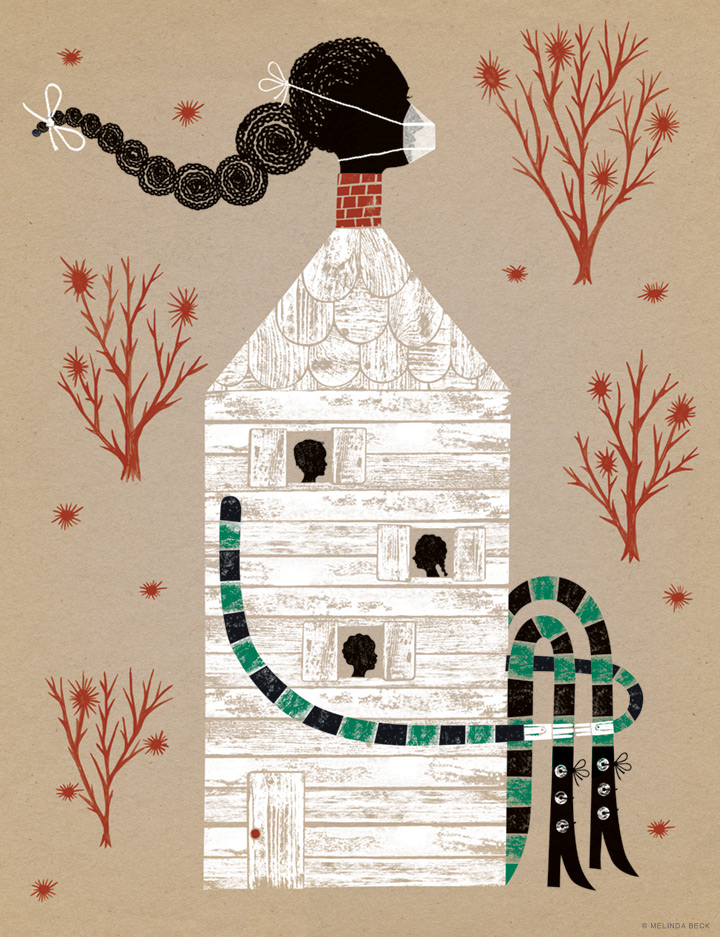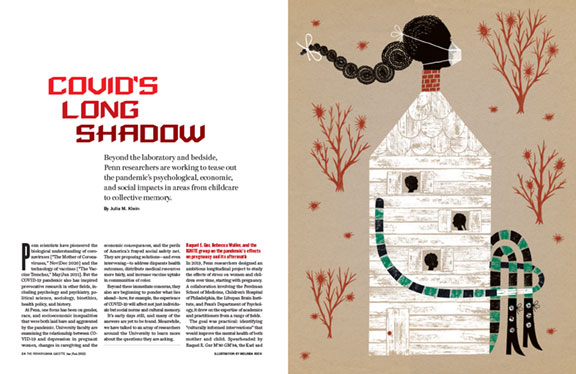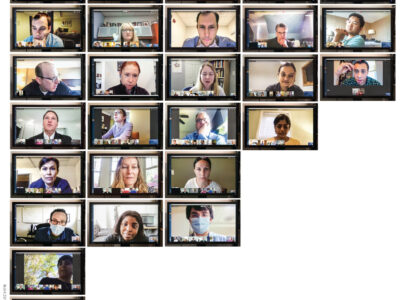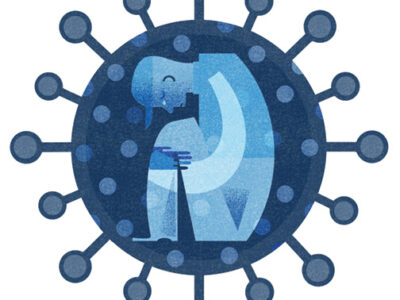
Beyond the laboratory and bedside, Penn researchers are working to tease out the pandemic’s psychological, economic, and social impacts in areas from childcare to collective memory.
By Julia M. Klein | Illustration by Melinda Beck

Penn scientists have pioneered the biological understanding of coronaviruses [“The Mother of Coronaviruses,”Nov|Dec 2020] and the technology of vaccines [“The Vaccine Trenches,”May|Jun 2021]. But the COVID-19 pandemic also has inspired provocative research in other fields, including psychology and psychiatry, political science, sociology, bioethics, health policy, and history.
At Penn, one focus has been on gender, race, and socioeconomic inequalities that were both laid bare and aggravated by the pandemic. University faculty are examining the relationship between COVID-19 and depression in pregnant women, changes in caregiving and the economic consequences, and the perils of America’s frayed social safety net. They are proposing solutions—and even intervening—to address disparate health outcomes, distribute medical resources more fairly, and increase vaccine uptake in communities of color.
Beyond these immediate concerns, they also are beginning to ponder what lies ahead—how, for example, the experience of COVID-19 will affect not just individuals but social norms and cultural memory.
It’s early days still, and many of the answers are yet to be found. Meanwhile, we have talked to an array of researchers around the University to learn more about the questions they are asking.
Raquel E. Gur, Rebecca Waller, and the IGNITE group on the pandemic’s effects on pregnancy and its aftermath
In 2019, Penn researchers designed an ambitious longitudinal project to study the effects of stress on women and children over time, starting with pregnancy. A collaboration involving the Perelman School of Medicine, Children’s Hospital of Philadelphia, the Lifespan Brain Institute, and Penn’s Department of Psychology, it drew on the expertise of academics and practitioners from a range of fields.
The goal was practical: identifying “culturally informed interventions” that would improve the mental health of both mother and child. Spearheaded by Raquel E. Gur M’80 GM’84, the Karl and Linda Rickels Professor of Psychiatry, and Michal A. Elovitz, the Hilarie L. Morgan and Mitchell L. Morgan President’s Distinguished Professor in Women’s Health at Perelman, the working group dubbed itself IGNITE, for the Intergenerational Exposome Program.
Then came the pandemic—a singularly significant and universal stressor that IGNITE incorporated into the study. The researchers used online questionnaires and Zoom calls to conduct interviews with more than 900 pregnant women. “We started before COVID,” says Gur, “but didn’t let it interrupt.”
“The idea behind the group sounds very intuitive,” says Rebecca Waller, assistant professor of psychology. “Of course we should study women in pregnancy, and then keep following them—and then look at the babies, and then see how their mental health works over the lifespan. But the actual challenge of doing that—of bringing together maternal fetal medicine, perinatal psychologists, psychiatrists, and neonatologists—is enormous.”
The group’s “keen social awareness of health disparity,” present before COVID-19 and America’s ongoing racial reckoning elevated the issue, shaped the research, Gur says. As a result, the study homed in on how various stressors—including the pandemic—affected the mental health of Black women.
IGNITE has produced two published papers so far and has others in the pipeline. “The Disproportionate Burden of the COVID-19 Pandemic Among Pregnant Black Women,” in the journal Psychiatry Research, examined the differential effects of COVID-related stressors on pregnant Black and white women during the spring 2020 lockdown. It found that anxiety and depression were greater among Black women—but so was resilience. “That was, in a way, inspiring,” says Gur, the lead author.
The paper noted that Black women, in general, have been more susceptible to poor pregnancy outcomes, including preterm birth and maternity-related illness and mortality. The research showed, Waller says, that in the pandemic’s early months “Black women were more fearful of infecting others, more fearful of having a financial burden because of the pandemic, definitely had their jobs negatively affected.” And those stresses added to “already existing endemic racist conditions and structures.”
The second published paper, “Risk and Resilience Factors Influencing Postpartum Depression and Mother-Infant Bonding During COVID-19,” in Health Affairs, reported that the biggest single risk factor for postpartum depression and impaired maternal-infant bonding was prenatal depression. Adverse childhood experiences, prenatal anxiety, and COVID-19-related distress also were associated with a greater likelihood of postpartum depression. Women with greater emotional regulation, self-reliance, and nonhostile relationships—all components of resilience—had healthier postpartum outcomes.
Coauthor Sara L. Kornfield, assistant professor of psychiatry, had done earlier work on women exposed to traumatic life experiences. “We see a lot of similarities between that sample and this sample,” she says. COVID-19 compounded the stresses of social isolation, financial insecurity, and limited access to childcare and medical care. Women also worried about giving birth in hospital settings that felt unsafe and being denied the supportive presence of family members. “These are really scary thoughts for women to experience at a really vulnerable time,” Kornfield says.
Another IGNITE paper in progress examines pregnant Black women’s experiences of racism, both interpersonal and structural, during the pandemic. Yet another compares women’s self-reports on their hospital labor and recovery with the information in their medical records. The birth experience “may have been incredibly traumatic,” says Waller, a mother of two, holding her own six-week-old son during a Zoom call. “Nobody necessarily follows up with you about that.”
Julia Lynch on the intersections of public policy, healthcare, and COVID-19
It took Julia Lynch, professor of political science, nearly a decade to complete Regimes of Inequality: The Political Economy of Health and Wealth (Cambridge University Press). The book, examining “the politics of inequality through a health lens,” was published in January 2020—just as COVID-19 was emerging as a global threat.
The pandemic turned a spotlight on the very issues that had been absorbing Lynch. “We’ve been screaming into the void for so long,” she says. But the impact of COVID-19 turned out to be “so much worse than I think any of us had even expected.”
Early on, a former Penn colleague working as a pulmonary intensive care physician asked Lynch to help set up a scarce-resource allocation team for his Michigan hospital. The hospital’s biggest pandemic-related problem was not a shortage of ventilators, but of nurses. The main question was how to allocate nursing time among patients, given the surge in COVID-19 cases.
Decisions about resource allocation typically had been the province of either hospital administrators, ethics boards, or individual doctors. Lynch instead advised holding meetings with a broader spectrum of hospital workers: administrators, doctors, nurses, respiratory therapists, patient representatives, and others. The process she devised called for each participant to speak, and for decisions to be made by ranked-choice voting.
The new process, she says, made the hospital better at anticipating future shortages, relieved the “moral distress” of bedside clinicians, and helped avoid the stereotyping sometimes inherent in rapid, on-the-spot decision making.
Another pandemic project was an effort, with two public health colleagues in the United Kingdom, to survey the intersections of COVID-19 with public policy and socioeconomic, racial, and ethnic inequalities. Lynch’s role was to compare policy responses in Western Europe and the United States. Published this past June, The Unequal Pandemic: Covid-19 and Health Inequalities (Bristol University Policy Press) emphasized the political roots of disparities in mortality, illness, impoverishment, and other COVID impacts. “The original inequalities leading to these unequal impacts were a result of prior political choices,” Lynch and her coauthors write. “Governments responded differently, and those with higher rates of social inequality and less generous social security systems had a more unequal pandemic.”
The United Kingdom, “the most unequal of the Western European countries, with social conditions that look most similar to the US,” also has “done quite poorly” during the pandemic, Lynch says. In contrast, Scandinavia and other northern European countries with “robust social safety nets” were able to get help out quickly to those who needed it.
As in the United States, “racial and ethnic minorities in Europe have done much worse than the majority native-born population,” Lynch says. “But in places where people overall are better protected by the social safety net, the differences are not as huge as they are here.”
Lynch nevertheless says that she was pleasantly surprised by some aspects of the US response, which involved “ramping up really quickly to do things that we had never done before.” Examples included near-universal cash payments, as well as the enhancement of unemployment compensation and its expansion to previously ineligible categories of workers. “It was a real success story,” she says, albeit a limited one.
“There were whole areas where we were not able to deliver anything,” she says, costing the country the labor-force participation of millions of women. “The Great Resignation was not a Great Resignation. It was a Great Push Out. Women with children were pushed out of the labor force and are continuing to be pushed out of the labor force because schools and daycare centers were not able to stay open. This has simply not happened on the same scale in any other country.”
The Push Out was linked to race and socioeconomic status. School districts with higher concentrations of minorities and lower income children were more likely to move to remote schooling than those in wealthier and whiter areas, research has shown. That obliged the affected parents, many of them unable to work remotely, to make what Lynch calls “terrible choices,” weighing their need for a paycheck against their fear of infection and the demands of childcare and home-based schooling.
The magnitude of the effect shocked Lynch. “I did not think that as a polity and as an economy the US would be willing to see that many women drop out of the labor force for so long,” she says.
President Biden’s Build Back Better legislation promises an infusion of federal support for childcare and pre-K schooling. But social change, Lynch says, will come only gradually. “It’s really hard to turn on a dime from offering no support to offering substantial enough support that it’s going to solve some of these underlying problems,” she says. “The problem is that our entire social safety net is so frayed.”
That COVID-19 has had such strong differential impacts on the already disadvantaged was no surprise, Lynch says. “It is one of the most robust findings in all of social science that there is an incredibly strong association between socioeconomic status and health status. So, this is not a test case,” she says. “This is a demonstration case.”
Motivated in part by her frustration with the often inaccurate data on cases and deaths that have been used to track the spread of COVID-19, Lynch is now researching a book on “how governments decide what kinds of data they’re going to collect about health and mortality to allow them to either see—or not see—inequalities.”
Pilar Gonalons-Pons on how—and why—the pandemic burdened women more
COVID-19 has inspired a “collective reckoning” over the inequitable distribution of care-related work, says Pilar Gonalons-Pons, the Alber-Klingelhofer Presidential Assistant Professor of Sociology and a visiting scholar this academic year at the Russell Sage Foundation. Her concerns include the political economy of caregiving and how gender shapes family dynamics—issues whose salience has been heightened by the pandemic.
Several studies have found that US women have been shouldering greater-than-usual shares of housework, childcare, and elder care. Gonalons-Pons has been analyzing the reasons for this additional “second shift” labor and the concomitant erosion of women’s economic standing.
In a May 11, 2020, opinion piece in the Philadelphia Inquirer, she wrote: “With schools and much of the service economy closing down, households now have even more work to do at home. It disproportionately falls on women’s shoulders.”
While economic factors—including women’s lesser incomes and withdrawal or ejection from the labor market—contribute to this disparity, “it is power dynamics within couples, fed by gendered expectations, that guilt women into doing more housework and care work, and make it easy for men to get away without chipping in,” Gonalons-Pons wrote, adding that male strategies to avoid assuming more of that unpaid labor range “from ignorance to subtle insinuation, even domestic violence.”
With Yasmin Mertehikian, a graduate student in sociology and demography, Gonalons-Pons has coauthored a working academic paper titled “Work and Family Disadvantage: Mechanisms of Gender Gaps in Paid Work During the COVID-19 Pandemic.” It aims to assess the differential impacts of economic factors and gender expectations in pushing women out of the workplace.
Gonalons-Pons explains that one argument, made mostly by economists, is that COVID-19 has hit women harder economically because of their “different position in the labor market”—their lesser pay and concentration in sectors, such as retail and hospitality, that were largely shut down. Many sociologists, however, emphasize instead the gendered social expectations around caregiving, a problem exacerbated when lockdowns shifted care responsibilities from paid to unpaid workers. Gonalons-Pons says that her research supports the latter view.
Using survey data, controlling for differences in men’s and women’s jobs, and examining different family compositions, she and Mertehikian established that gender inequality in paid work increased most in families with children. “The baseline is that there are gendered expectations that are at play,” results that hold for Hispanic, Black, and white families. Even in households where women initially earned more money than their male partners, their economic standing eroded during the pandemic. But the erosion was greater when women started out earning less.
When it comes to solutions, Gonalons-Pons says, “I’m a big proponent of policies that redistribute care responsibilities in ways that are egalitarian” in terms of both gender and socioeconomic status. That entails creating “a robust public infrastructure for childcare” and paid leave policies. She posits that an influx of money for caregiving, including elder care, would likely improve the circumstances of both workers and those they care for—a phenomenon that Gonalons-Pons plans to study. She also contemplates undertaking cross-cultural research looking at “how much preexisting policies and supports matter.”
One larger lesson from the pandemic involves the persistence of what Gonalons-Pons calls “gender culture.” Whatever advances were spurred by second-wave feminism, we may have assumed ourselves to be more egalitarian than we are, she suggests. “COVID revealed how pervasive it still is,” she says, “that women find themselves, willingly or unwillingly, with way more responsibility for caring for other people”—with all the attendant economic costs.
Harald Schmidt on making ventilator and vaccine distribution more just
Working at the bioethical frontiers of the pandemic, Harald Schmidt, assistant professor of medical ethics and health policy, has investigated ways to improve equity in the distribution of both ventilators and vaccines.
Schmidt, a research associate at Penn’s Center for Health Incentives and Behavioral Economics and a senior fellow at the Leonard Davis Institute of Health Economics, says that his ideas already have had an impact: the National Academies of Science, Engineering and Medicine Committee adopted his rationale for incorporating a statistical measure of disadvantage into vaccine allocation. NASEM’s October 2020 framework shaped the subsequent debate, he says, leading more than 40 states and other public-health jurisdictions to use indices of disadvantage or ZIP codes to help prioritize vaccine distribution.
With numerous collaborators, including Penn Integrates Knowledge Professor Dorothy E. Roberts, Schmidt also has critiqued the current criteria used in ventilator rationing, saying they are inaccurate and risk compounding disparities in health outcomes for historically disadvantaged communities.
Those criteria, embodied in a Sequential Organ Failure Assessment (SOFA) score, are philosophically utilitarian, aiming to preserve the largest number of lives or life years. One problem, Schmidt says, is that SOFA measurements predict a higher-than-actual Black mortality rate. Yet the handful of states that have activated Crisis Standards of Care for rationing ventilators during COVID-19 surges have relied on those discredited metrics, he says.
Nor is that the only issue. “In public health emergencies,” he says, “we maximize benefits—that’s the received wisdom. And everybody who has their eyes open realizes that if we do this, worse-off people”—those with poorer overall health and lower life expectancies—“will be hit harder,” aggravating already disparate outcomes linked to race, poverty, and geography. That conclusion, he notes, was ratified by the Presidential COVID-19 Health Equity Task Force in its October 2021 report, which recommended that a multidisciplinary panel update the Crisis Standards of Care with equity as a core value.
Some have argued, Schmidt says, that the middle of a pandemic is no time to be wrestling with these thorny systemic problems. But retaining the status quo, to Schmidt, means “rolling out the same system that has disadvantaged the same groups over generations. And that means that the medical system becomes complicit in imposing these structures that aren’t by themselves neutral.”
What standards would be fairest remains a matter of debate, Schmidt says. There is general agreement, he says, “that futile care is what we want to avoid”—that is, giving a ventilator to someone whose death is an imminent certainty. “Physicians are pretty good at predicting that,” he says. What is trickier is relying on longer-term prognoses, using one-year or five-year time horizons. Those are not only more uncertain but, Schmidt says, bound to further disadvantage the already disadvantaged. “It could be the most equitable to do a lottery among the people for whom care will not be futile,” he suggests. In an April 2020 opinion piece for the New York Times, he proposed using “fairness weights” to compensate for structural disadvantages—an idea he says is gaining wider acceptance.
Vaccine distribution, when supply is scarce, raises similar issues. Studies have shown a “clear association between disadvantage and the likelihood of getting and spreading and dying of COVID,” Schmidt says. So, using disadvantage indices—alongside factors such as age, occupation, and co-morbidities—makes sense to Schmidt, and many states and other jurisdictions (including Philadelphia) have agreed.
The Centers for Disease Control and Prevention’s Social Vulnerability Index, initially developed for disasters such as hurricanes and earthquakes, is the most widely used of these indices, Schmidt says. Based on US Census data, it incorporates 15 variables, including race, income, disability, age, and crowding. Another measure, the Area Deprivation Index, targets a smaller geographic area. And while it doesn’t use race as a variable, its reliance on socioeconomic factors tends to benefit racial minorities and might be more legally tenable, Schmidt says. “Social justice is very intricately intertwined with the question of racial justice,” and these indices, Schmidt says, can advance both.
The adoption of disadvantage indices in vaccine distribution “marks a watershed moment,” Schmidt says, “in which we recognize that we can’t any longer ignore these inequities that COVID has exposed with such cruel clarity.” And with children 5 and older now eligible for the vaccine and boosters on offer for all adults, he says, “the equity story isn’t over yet.”
Florence Momplaisir on improving vaccine uptake in the Black community
The work of Florence Momplaisir Gr’12, assistant professor in Perelman’s division of infectious diseases and a senior fellow at the Leonard Davis Institute of Health Economics, is a dialectical blend of academic research and practice.
Momplaisir began studying attitudes toward COVID-19 vaccines among both communities of color and healthcare workers months before the vaccines were approved. She has continued to track those attitudes over time, and her studies have informed community interventions aimed at both improving access and decreasing vaccine hesitancy.
“My passion is really to empower communities that are underserved, and improve health outcomes, and particularly to address racial disparities in health,” says Momplaisir, who was born and raised in Haiti.
Much of her past research has focused on HIV infection in pregnant and postpartum women. “There are several parallels between the COVID pandemic and the HIV pandemic,” she notes. Both, over time, have had a disproportionate impact on Black and Latinx communities. “What’s upsetting is that those stories don’t need to be told over and over again through different viruses,” she says. “We know that social determinants are real and that they contribute to health inequities. We need to do a better job of addressing them to achieve equity—but also to improve health in general.”
In two early papers, Momplaisir and her coauthors found high rates of concern about COVID-19 vaccination within the Black community and among healthcare workers from communities of color, as compared to their white peers. Two more recent papers, for JAMA Network Open, found that vaccine hesitancy persisted, particularly among Black and Latinx healthcare workers.
Along with Krystal Hill M’20 and Norrisa Haynes, a senior cardiology fellow and master’s student in health policy and research at Perelman, Momplaisir has teamed with a Philadelphia coalition of Black barbers and salon owners in community vaccine education efforts. Those have included meetings where people could express their fears, often about potential side effects and the newness of the vaccines, as well as their distrust of a healthcare system seen as distant, uncaring, or racist. In return, they received factual responses and information about what remained uncertain, Momplaisir says.
What’s been rewarding, she says, has been observing the evolution in attitudes among the barbers and salon owners themselves, from being mostly anti-vaccine to becoming “vaccine champions.” The change arose in part, she says, from their observation of the outsized impact of COVID-19 on their communities in terms of illness, death, and the shuttering of businesses. They realized, she says, that “it’s not a hoax—people are really dying, and they’re primarily dying in underserved communities.”
Penn has set up community clinics in churches, schools, and other locations to improve access. With Heather Klusaritz, associate director of Perelman’s Center for Community and Population Health and director of community engagement for Penn’s Center for Public Health Initiatives, Momplaisir is exploring making vaccines available at other “trusted venues” such as barbershops and salons.
Beyond the access problem, there is hardcore resistance. “It feels like we’re hitting a wall,” Momplaisir concedes. But the barbers and salon owners, she says, “have amazing ideas,” including a prospective social media campaign to get teenagers “excited about vaccinations”—a solution “from the community, for the community.”
Her own involvement “helps, but doesn’t alleviate all of the fears,” she says. “Yes, I’m a physician of color. But I also come from Penn, a system that historically has not provided access to communities of color. It takes time to build trusted relationships.” To teenagers and others who see themselves at less risk from the virus, she says, “the message we send is that by getting vaccinated you care for yourself, but also care for your loved ones, for your community.”
Since she began the research, she says, her attitude toward mandates has shifted. Initially, she was concerned that they would further disadvantage Black and brown communities by costing jobs. But the improved uptake of vaccines in those communities has been “very encouraging,” she says. And by the time Penn instituted mandates for its healthcare workers, “the majority of the workforce was already vaccinated.”
For the future, Momplaisir says she would like to understand better how to drive vaccine acceptance. “We’ve tried a lot of things. We tried social media, mass media. We tried the one-on-one conversation. We tried selecting the trusted messengers. We tried increasing access. We’re trying the mandates. But at the end of the day,” she says, “understanding which strategies are more effective—and particularly for what group of individuals—is a very important question.”
Projit B. Mukharji on collective memory and trauma
When the pandemic does finally end, what will we remember? And how will the trauma of the experience affect our lives—and stories—going forward?
These are some of the broad questions that engage Projit B. Mukharji, associate professor of history and sociology of science. Mukharji has so far pursued two specific pandemic-related lines of research.
One, with collaborators in Germany and the United Kingdom, looks at how India’s state health system—which recognizes not just Western-style “biomedicine” but traditional medicine—deals with competing notions of “breathable air.” In India, “you can get a degree in one of five different traditional medicines and go and work in the public health system,” Mukharji says. And during India’s brutal second wave of COVID-19, controversy broke out over what he calls “different understandings of air.” One such imbroglio, he says, involved disputed claims by some practitioners of Ayurvedic medicine that breathing exercises could help prevent COVID-19.
Mukharji’s second project examines how ghost stories in the Bengal region of South Asia, which encompasses eastern India and Bangladesh, have helped process the trauma of the region’s 19th-century cholera and malaria epidemics.
As a historian, Mukharji says he has pondered how those earlier epidemics have been remembered. “What I was struck by is that there’s a lot of historical literature on various epidemics and pandemics, but all of that looks at how an epidemic starts or how it stops or how people manage it, but there’s little about the afterlife,” he says. “Anything that kills a lot of people is going to cause trauma. We are only now beginning to appreciate that trauma is not just a very individualized thing, but that trauma can be collective. A community can share trauma.”
Part of the social work of trauma, he says, is connecting the past, present, and future, serving as “the link between our experiences of time.” Mukharji employs the coinage “spectral communities,” which he says has two distinct meanings. It can refer to communities that share stories about ghosts, he says, or, more generally, to a community’s shared stories of the past.
Sometimes, he says, concurrent traumas can become hard to distinguish. The early 20th-century flu pandemic, for example, “gets so entangled with the First World War, the memories conflict.” So, too, with the 19th-century cholera and malaria epidemics. And new traumas can trigger memories of older ones, as the COVID-19 pandemic has done for the flu pandemic.
Mukharji says he also has become interested in sites of collective memory, both physical and digital. In India, for example, the National Covid Memorial allows mourners to contribute a photograph and a few lines about the loved ones they have lost. “This is something new,” Mukharji says.
People’s identities—and those of the collectives to which they belong—often involve the invocation of a founding trauma. “That might be the Fall of Man in the Garden of Eden, or a revolutionary war, or anti-colonial struggles,” he says. “You invoke a particular past, you imagine a particular future, and you locate your present in that continuum.
“And we need to study that more without prejudging the factuality,” he says. “Ghosts may exist or not exist, but if a house is supposed to be haunted, its market value often falls. It has social consequences that have nothing to do with its factuality.”
Mukharji also worries about the erosion of historical evidence as paper records disappear. “The digitalization of stuff has augmented the potential for creating counternarratives, but also enhanced their ephemerality,” he says. “We think it’s all getting stored in some kind of ether, but it needs a company, a website, a server, and we’re still not sure who’s going to maintain them.”
While the politics and science of the pandemic will be easy to access, Mukharji says, “we’ll not have a lot of records about how people actually dealt with loss and trauma.” The solution, he says, may involve citizen archivists, paralleling the scrapbookers of Victorian times. “Trauma—when it is of such scale as we have had—is not going to just disappear without leaving some kind of a social consequence,” Mukharji says.
Julia M. Klein is a regular contributor to the Gazette. Follow her on Twitter @JuliaMKlein.





The truth is most people still don’t care about covid. They don’t even consider the consequences they might face with this virus. That’s horrible and I’m afraid even though I’m fully vaccinated. well written and best of luck with the new article :)
good info thanks for sharing this great information.